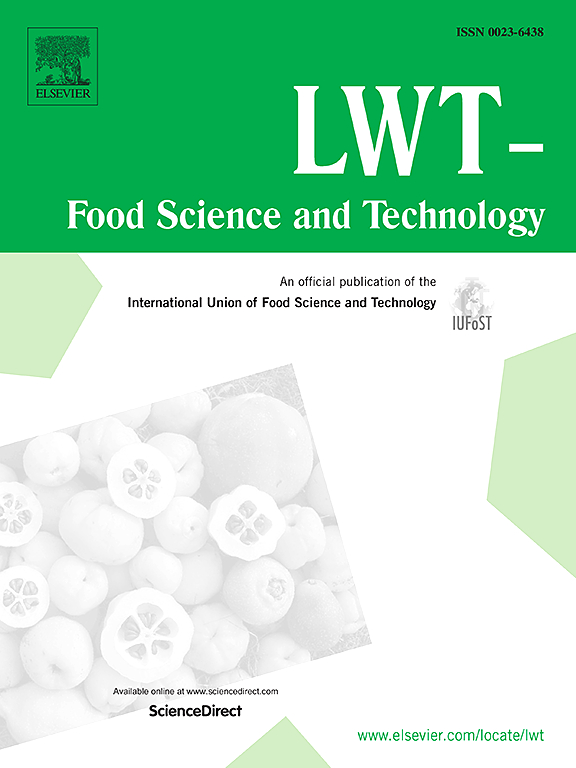基于lstm的混合模型对胡萝卜天然深共晶溶剂微波萃取生物活性化合物含量和抗氧化活性的预测比较
IF 6
1区 农林科学
Q1 FOOD SCIENCE & TECHNOLOGY
引用次数: 0
摘要
天然深共晶溶剂(NADES)是一种绿色溶剂,当与微波辅助萃取(MAE)结合使用时,可以显著提高生物活性化合物提取的效率和可持续性。本研究采用长短期记忆-长短期记忆(LSTM-RSM)、长短期记忆-贝叶斯响应面法(LSTM-BRSM)和LSTM-Box Behnken 3种混合模型,比较了NADES联合MAE对胡萝卜生物活性物质提取的预测效果。实验共进行了40次,考察了5个关键参数:微波功率(400-600 W)、温度(50-70℃)、提取时间(10-40 min)、样品质量(0.5-1.0 g)和乳酸浓度(1-2 mol/L)。除了总酚含量、总黄酮含量和1,1-二苯基-2-苦味肼基自由基(DPPH)清除活性外,还对模型的预测能力进行了测试。灵敏度分析表明,微波功率决定酚类含量,样品质量决定抗氧化活性,温度决定黄酮类提取。本研究首次提出了一种新的、可持续的方法,将NADES与MAE相结合,从胡萝卜中提取生物活性物质,显著缩短了提取时间,减少了有毒溶剂的使用,提高了整体效率。在此基础上,首次提出了基于lstm的混合预测模型lstm - rsm、LSTM-BRSM和LSTM-Box behnken。其中,LSTM-Box Behnken模型表现出优异的预测能力(R2 >;0.99),强调了在提高生物活性化合物的回收过程中,先进的建模技术和环境友好的提取技术之间存在的协同作用。本文章由计算机程序翻译,如有差异,请以英文原文为准。
Comparative evaluation of hybrid LSTM-Based Models for predicting bioactive compound contents and antioxidant activity in microwave-assisted extraction from carrots using natural deep eutectic solvents
Natural deep eutectic solvents (NADES) are green solvents that, when used in combination with microwave-assisted extraction (MAE), significantly improve the efficiency and sustainability of bioactive compounds extraction. In this study, three hybrid models, Long Short-Term Memory-Long Short-Term Memory (LSTM-RSM), Long Short-Term Memory-Bayesian Response Surface Methodology (LSTM-BRSM), and LSTM-Box Behnken, were used and compared for predicting bioactive compounds extraction from carrots using MAE with NADES. An experiment involving 40 runs examined five critical parameters: microwave power (400–600 W), temperature (50–70 °C), extraction time (10–40 min), sample mass (0.5–1.0 g), and lactic acid concentration (1–2 mol/L). In addition to total phenolic content, total flavonoid content, and 1,1-diphenyl-2-picrylhydrazyl radical (DPPH●) scavenging activity, the models were tested for their predictive capabilities. According to the sensitivity analysis, microwave power dominates phenolic content, sample mass dominates antioxidant activity, and temperature dominates flavonoid extraction. For the first time, this study presents a novel and sustainable approach for extracting bioactive compounds from carrots by combining NADES with MAE, significantly reducing extraction time, minimizing the use of toxic solvents, and enhancing overall efficiency. In addition to this green extraction technique, three novel hybrid LSTM-based predictive models—LSTM-RSM, LSTM-BRSM, and LSTM-Box Behnken—are introduced for the first time. Among them, the LSTM-Box Behnken model demonstrated excellent predictive ability (R2 > 0.99), highlighting the synergy that exists between advanced modeling techniques and environmentally friendly extraction technologies in the process of enhancing the recovery of bioactive compounds.
求助全文
通过发布文献求助,成功后即可免费获取论文全文。
去求助
来源期刊

LWT - Food Science and Technology
工程技术-食品科技
CiteScore
11.80
自引率
6.70%
发文量
1724
审稿时长
65 days
期刊介绍:
LWT - Food Science and Technology is an international journal that publishes innovative papers in the fields of food chemistry, biochemistry, microbiology, technology and nutrition. The work described should be innovative either in the approach or in the methods used. The significance of the results either for the science community or for the food industry must also be specified. Contributions written in English are welcomed in the form of review articles, short reviews, research papers, and research notes. Papers featuring animal trials and cell cultures are outside the scope of the journal and will not be considered for publication.
 求助内容:
求助内容: 应助结果提醒方式:
应助结果提醒方式:


